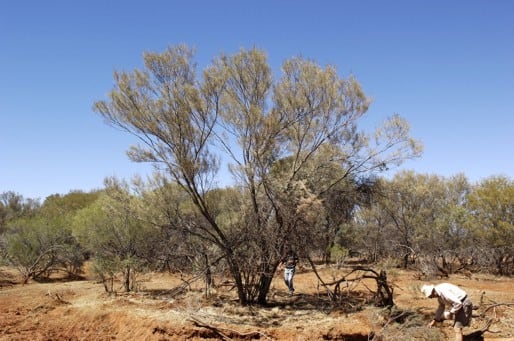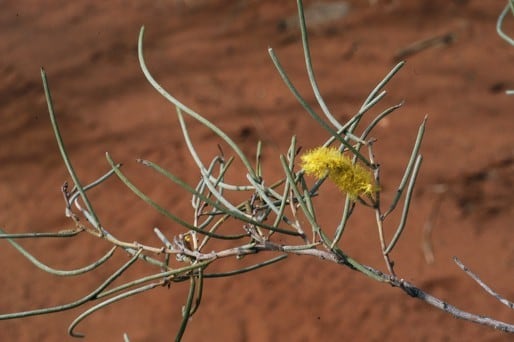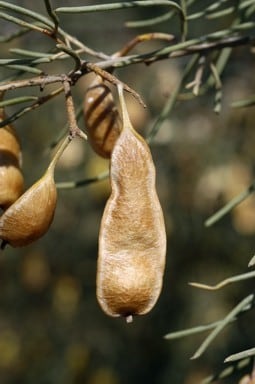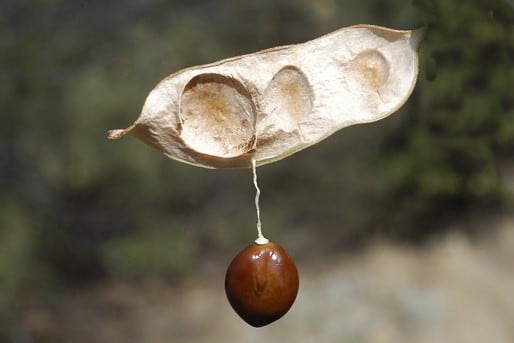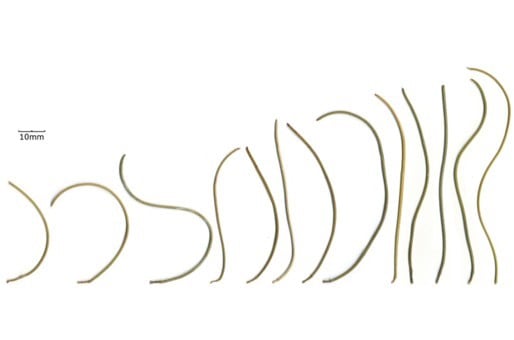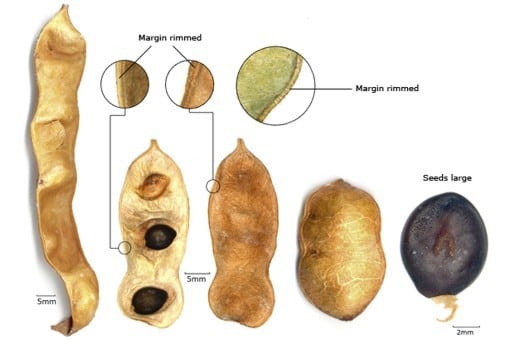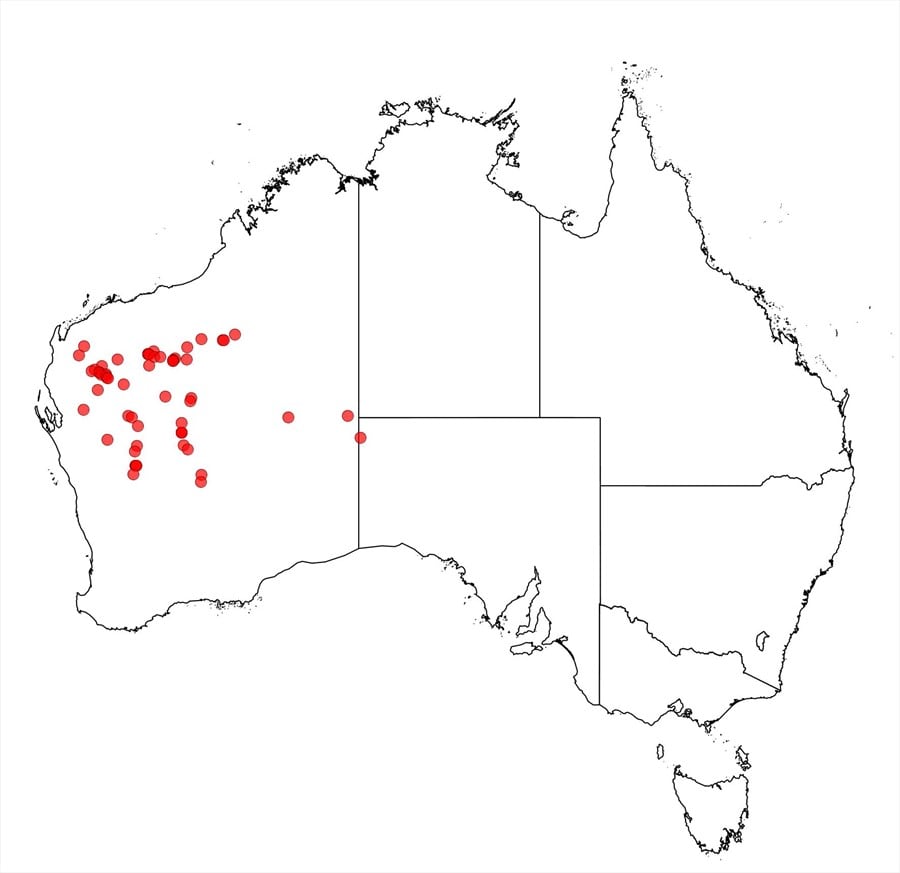Acacia macraneura Maslin & J.E.Reid
WATTLE
Acacias of Australia
Common Name
Big Mac Mulga
Family
Fabaceae
Distribution
Mostly confined to W.A. where it is scattered from near Mt Magnet and Leonora (110 km W of Laverton) N to the southern Pilbara region and the Rudall R. area in the northern Little Sandy Desert; also in S.A. from Mt Agnes (near the W.A–S.A. border).
Description
Spreading, multi-stemmed shrub commonly 2–5 m high, sometimes an obconic tree to 4–6 (–7) m, stems and branches often somewhat crooked. Branchlets minutely appressed-puberulous and obscurely ribbed at extremities, the ribs often with a layer of translucent resin; new shoots resinous, with scattered red-brown glandular hairlets. Phyllodes incurved or sigmoid to sinuous, normally terete, 4–7 (–9) cm long, 0.8–1.1 mm diam., green to grey-green with bluish tinge, longitudinal nerves numerous and obscure; gland 0–3 mm above the pulvinus, phyllode normally swollen, curved upwards and/or ±kinked at gland. Inflorescences simple; peduncles 5–15 mm long, ±glabrous; spikes 10–20 mm long. Flowers 5-merous; sepals free or shortly united at base, ½–2/3 length of petals; petals 1.3–1.5 mm long. Pods oblong to narrowly oblong, (1.5–) 2–7 (–10) cm long, 12–22 mm wide, thinly coriaceous, flat or undulate, slightly to obviously rounded over the seeds, normally yellow to light brown and glabrous, resinous; margins rimmed by a thick, resinous nerve. Seeds transverse, oblong to elliptic or round, compressed, 7–9.5 mm long, 5–7 (–8) mm wide; aril small.
Habitat
Mostly found in clay or loam associated with calcrete, often on floodplains or shallow drainage systems, in open mixed Mulga communities with ground cover comprising grasses (e.g. Aristida contorta, Enneapogon polyphyllus) or low shrubs such as Ptilotus spp. or Eremophila spp.
Specimens
W.A.: Upper Rudall R. area, B.R.Maslin 2216 (BRI, CANB, K, PERTH); 54 km N of Gascoyne Junction on rd to Eudamullah Stn, B.R. Maslin, J.Miller & J.E.Reid BRM 9175 (AD, PERTH); 0.4 km S of Carrowina Ck [NE of Newman], P.G.Wilson & R.Rowe PGW 956 (BRI, NSW n.v., PERTH). S.A.: Mt Agnes, Blyth Ra., 25 Sept. 1955, W.S.Reid s.n. (AD).
Notes
Sometimes putatively hybridizes with A. paraneura on floodplains near Newman in the Pilbara, e.g. B.R.Maslin & J.E.Reid BRM 10071 (PERTH) and rarely with A. pteraneura near Meekatharra, e.g. B.R.Maslin 9065 (PERTH); seemingly also rarely putatively hybridizes with A. craspedocarpa and possibly A. aptaneura (see these species for notes). L.Pedley, loc. cit., suggested that the unusual specimen B.R.Maslin 2183 (PERTH) from the Rudall R. in the Little Sandy Desert may be a hybrid between A. aneura var. macrocarpa (= A. macraneura) and A. ramulosa; B.R.Maslin & J.E.Reid, Nuytsia 22(4): 221–228 (2012), agree that hybrid origin for this specimen is likely but they regard parentage as uncertain.
A member of the ‘A. aneura group’ (Mulga) most closely related to the more widespread and common A. aptaneura but distinguished by its normally broader, more thickly textured and commonly paler-coloured pods containing larger seeds, and by its generally more shrubby grow form; also, its phyllodes are often slightly thicker, shorter, more prominently curved or sinuous and more discernibly swollen or kinked at the gland than in A. aptaneura. In the absence of pods it can sometimes be difficult distinguishing between these two species. The phyllodes of A. macraneura are always terete (flat to terete in A. aptaneura). Genetically A. macraneura is related to A. fuscaneura but morphologically the two species are very dissimilar, see B.R.Maslin & J.E.Reid, loc. cit., for discussion.
This taxon was treated as A. aneura var. macrocarpa by L.Pedley, Fl. Australia 11B: 317 (2001), but B.R.Maslin & J.E.Reid, loc. cit., consider it warrants recognition as a distinct species.
FOA Reference
Data derived from Flora of Australia Volumes 11A (2001), 11B (2001) and 12 (1998), products of ABRS, ©Commonwealth of Australia
Author
B.R.Maslin
L.Pedley
This identification key and fact sheets are available as a mobile application:
URL: https://apps.lucidcentral.org/wattle/
© Copyright 2018. All rights reserved.


